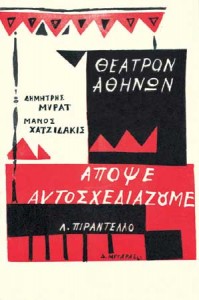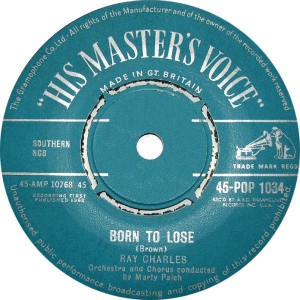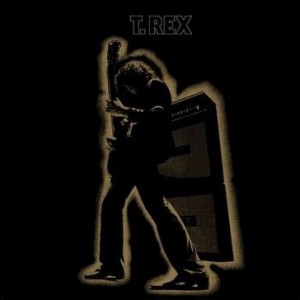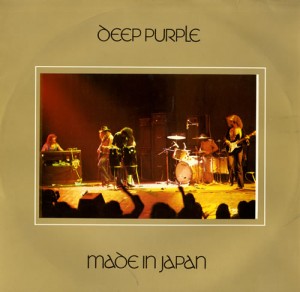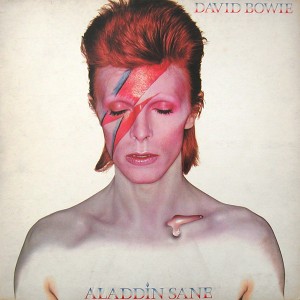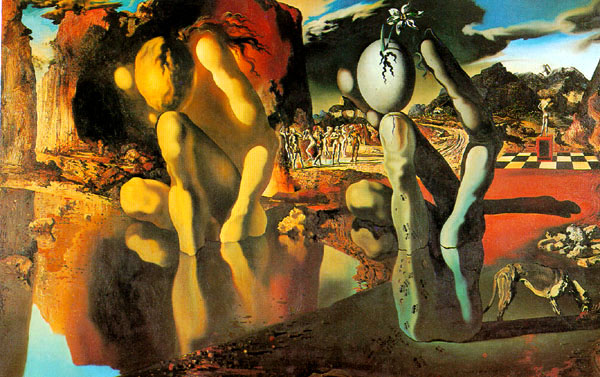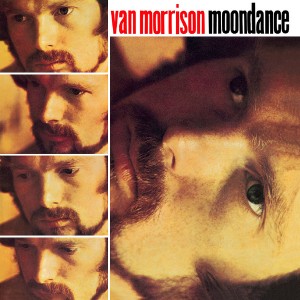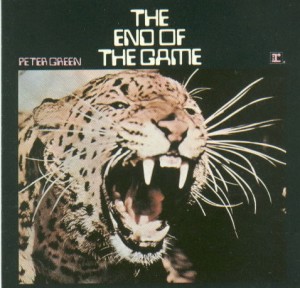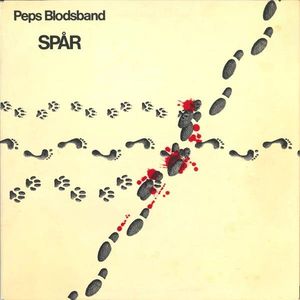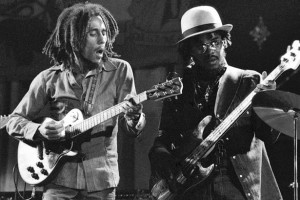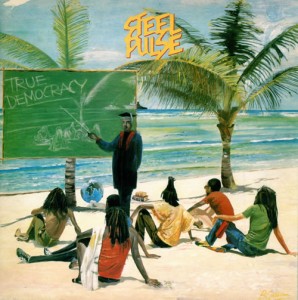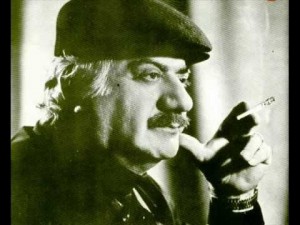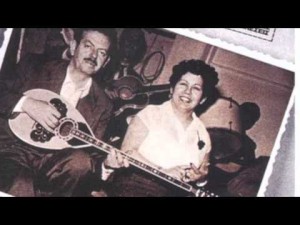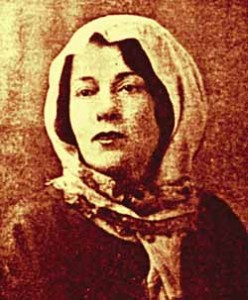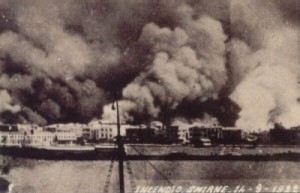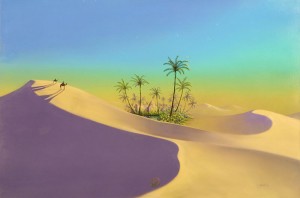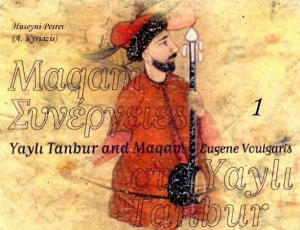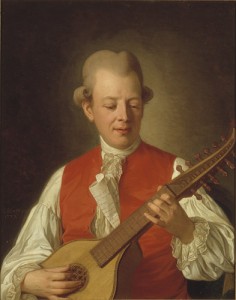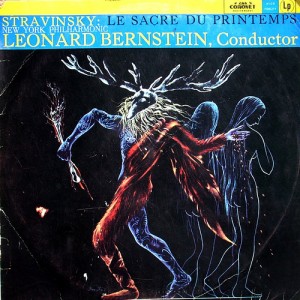I was asked to make a music list, a list of songs, albums and artists that have influenced me the most until now. As everybody can understand this seemed to be an impossible task. As music, sweet music, has been a close companion all my life – both playing and listening to – there would be hundreds of songs, albums, artists involved. How should I be able to prefer or exclude some before another and limit the list to a comprehensible size?
However, I found the idea quite challenging, so I gave it at try. The result is a minimal, compact and absolute distillation that reflects and is connected to various periods of my life, not necessarily put in chronological order.
Childhood – Teppaz and a mandolin
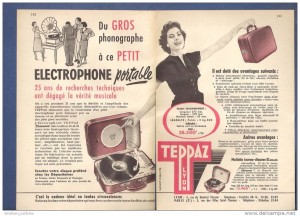
Teppaz, the portable “electrophone”
One evening in the beginning of 60’s my father came home with a so called electrophone, a portable Teppaz. This was my introduction to the world of music on vinyl records. The Teppaz could play records in 45, 33 and 78 rpm. Yes, I did have a lots of fun playing the records in wrong rpm – but beside that I also listened to them in normal speed and got immediately fascinated.
So My Music List will start with one of our first records, an EP (Extended Play). Click on cover below to listen to it on YouTube:
1. Αποψε αυτοσχεδιάζουμε – (Tonight we improvise) – music by Manos Xatzidakis:
I was especially caught by the 3d and 4th songs: Ο ΤΑΧΥΔΡΟΜΟΣ ΠΕΘΑΝΕ and ΤΟ ΜΑΝΤΟΛΙΝΟ (Ζωη Φυτουση) – “The postman died” and “Bring me a mandolin“, vocals Zoi Fytousi.
In that period I also got as present my first musical instrument: a real mandolin from Moscow, decorated with beautiful Russian ornaments. I fully enjoyed to improvise on it, but I doubt if my parents appreciated my compositions as much as I did.
***
2. Karagiozis – Greek shadow theatre
Karagiozis, played by Evgenios Spatharis, was another of the first records acquired. A very early influence with deep impact on me.
Eventually, I constructed my own small Karagiozis-theater and charged some coins entrance from the neighbourhood kids to watch it. In the business from early age! The Teppaz playing and me moving the carton figures in synchronization. It became a success!
***
3. “Born to loose” with Ray Charles
Another of the first home discography, actually my first “bluesy” listening, a favourite of my father. I still clearly remember how thrilled I was from Ray Charles’s voice.
***
4. The Jungle Book – King Louie song
Before moving to Sweden I had already become acquainted with The Jungle Book by R.Kipling in book format. It was one of my favourite children books back in Athens. The Walt Disney film came a few years later, when we already had moved to Sweden, and I was immediately getting caught! I saw the film many times in a row. Beside the funny and beautiful cartoons, there were also those incredible songs that I quickly learned by heart, the Swedish versions of them of course. Most of them all I still remember the song of King Louie, “Jag vill ju va’ som du” – I wanna be like you . Click οn King Louie to watch.
Teenager – in Bergshamra

“Vattentornet” – the water reservoir in Stockholm suburb, Bergshamra, where i lived my early teens
5. Marc Bolan and T-Rex:
Marc Bolan became my teenage obsession. I had (and still have somewhere) a huge collection of all his records, from the early acoustic and more poetic stuff of Tyrannosaurus Rex, to the later and wider known commercial glamour-rock of T-Rex. The walls of our children room – I shared room with my younger sister – were full of posters and pictures of my idol. I felt an unexplained deep connection with his persona, his music, his stage appearances and his texts. Click on the cover below to listen to the album Electric Warrior.
***
6. Deep Purple, Made in Japan
I was for the first time touching an electric guitar around 1972-73 in a basement room in school where we tried to establish our first band. We aimed to sound rock but now in retrospect I think it sounded more like hardest punk! We were complete autodidacts, but the orgasmic thrill when playing the first chords of – yes, what else – Smoke on the Water with distortions on max, was unbeatable. Made in Japan became something like a Bible for trying out the first guitar riffs.
Soon more riffs were added, from Led Zeppelin, Black Sabbath, etc. The music from the basement eventually became dangerous for the environment. I remember one day, the teacher of some lower-class from the floor above came down and asked us to stop the cacophony cause her pupils got scared. She characterized it as …just death and ghost scrap.
***
7. Ziggy and Aladdin
Finally, just before moving away from Bergshamra and back to Greece, I accidentally came across some Bowie-records. They left me astonished! Both the music and the performance were like science fiction, like a time travel, like coming in from the future.
It was not only songs like Space Oddity with Major Tom that then followed us for a life time (click on cover above to watch). David Bowie also impersonated a transition to the next Era and the introduction to artists like Lou Reed and Iggy Pop.
Rock Era:
The image above, a poster of the famous Salvador Dalí painting, symbolizes this truly narcissistic, but also high-level surrealistic period. It was documented with tons of automatic writing and flavoured by paranoia-critical delirium. Actually, I had such a poster of the painting taped on the ceiling above my bed so I could meditate on it before falling asleep. And there are many other stories about the madness & wisdom of that period, accompanied by the plethora of it’s musical ecology. It’s reflected by the next group of songs, albums and artists in my list.
8. Sympathy for the Devil – Rolling Stones.
If you would ask me to keep one and only rock song from that era, it should be the Sympathy. It is claimed that the song was inspired by the book Master and Margarita by Russian author Mikhail Bulgakov. In any case, the making up from scratch of the song, back in 1968, was filmed by Jean-Luc Godard and used in his film originally named One Plus One.
http://youtu.be/D8K6SUFt9Vs
If you prefer a truly ethnic flavoured live performance of the song you can watch this gig of the Stones at Hyde Park 1969. By the way, it was also Mick Taylor’s first public gig with the band.
***
The Holy Trinity
No music list would be complete – especially not of an ex street-musician without some songs of the holy three: Bob Dylan, Neil Young, Van Morrison. There are of course uncountable well known songs of each artist here with great influential value, throughout the decades. My distillation is based on very personal experiences and marks important stations in life. Click on covers below to listen:
9. Bob Dylan – One more cup of coffee
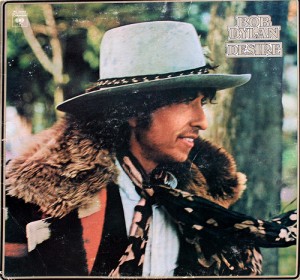
One more cup of coffee – probably the song I have played most frequently on the acoustic guitar. Here in the rare version.
10. Neil Young – On the beach (Revolution Blues)
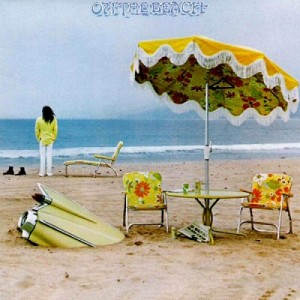
On the beach – The album symbolizes deepest connection with my escape to the Cycladic islands. Click to listen to one of my favourite tracks: Revolution Blues
11. Van Morrison – Moondance
***
12. Dire Straits
Talking rock-era, I cannot exclude a very important and influential album that came as fresh, new hope in a period when we thought rock has started to stagnate – it was about the middle of 70’s.
***
Blues guitar

13. Guitar Album
A great introduction to the blues guitar playing was for me the legendary Guitar Album 1972, featuring many giants of the blues guitar, such as Jimi Hendrix, Eric Clapton, BB King, Albert King, Harvey Mandel, Shuggie Otis and many more. Click on cover to listen.
14. Peter Green
One great guitarist, strangely not featured in the album above, is Peter Green, who eventually became my absolute favourite. By clicking on the cover of legendary album “The end of the game” – a personal life follower, you come to a fantastic version of “Fool No More”.
***
Swedish musical aspect
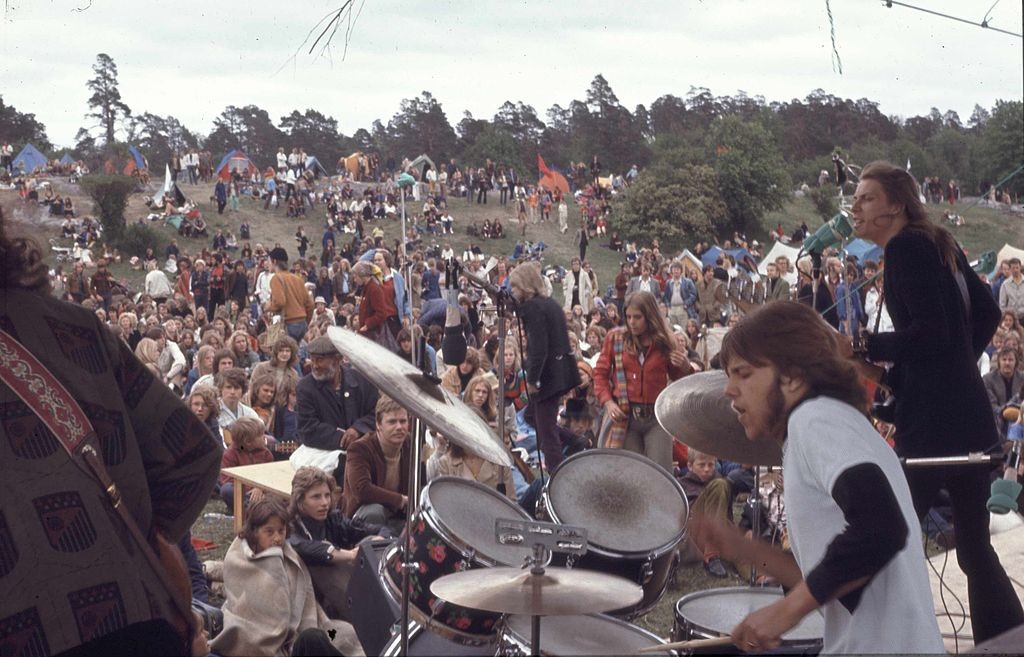
The festivals on the lawns of Gärdet, something to long for later when being far away
Thereabout end of 70s, quite bohemic and carefree, reading poets like Bruno K. Öjer and enjoying unforgettable outdoors concerts at the lawns of Gärdet, short before finally leaving Sweden. There are many representatives of that period: Nationaltetatern, Ulf Lundell, Roffe Wikström, Rävjunk, DagVag …
But I think the most influential were the following:
15. “Spår” – the album when Peps Persson turned reggae
16. Ebba Grön
Actually any of their known songs could be listed here, but clicking the image below you will come to a live version of the ska-ish & punk-ish Mamma Pappa Barn:
***
Breaking up with the known
It was a hard decision in the middle of the winter – beginning of 80s, to leave the medicine school and hit the Road to the unknown, instead of becoming a doctor, according to the parents wishes. But on that travel I did have some guiding stars.
17. Pink Floyd – The Wall
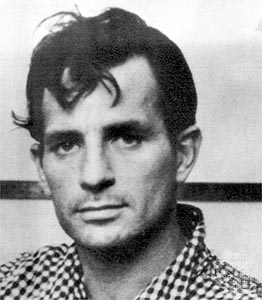
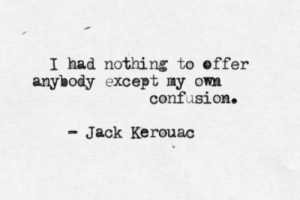
Amorgos – new horizons
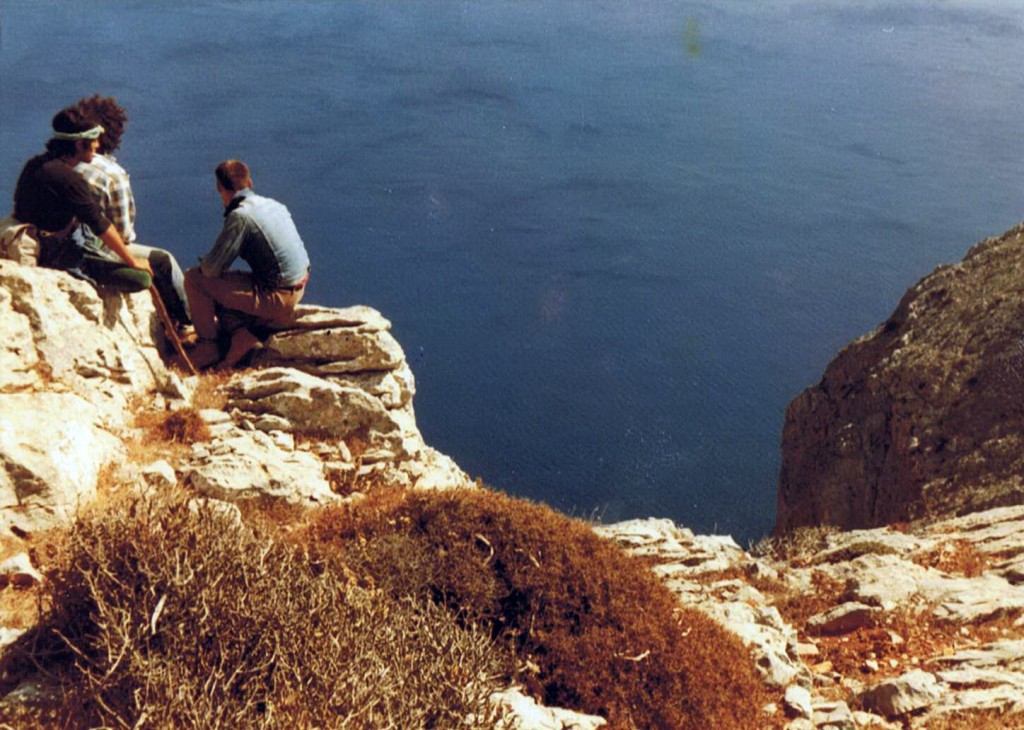
Encountering the Big Blue in 1982, at the steep North Eastern coast of Amorgos, Cyclades, Greece
They say that a Cycladic island can change your entire life. This was about what happened to me when I finally found my way to the island of Amorgos, harbour of Aigiali, in the summer of 1982. A new era in life had just begun.
There is no way to describe the attraction in just some few words. The underlying experience was like a pagan ritual – we called our local goddess “Lola” and danced to her honour countless wild summer nights through. Yes, I was often seriously wondering if I had landed in heaven.

DiscoTheQue, by the waves, long and wild summer nights through, until the magic of twilight
No surprise I then also got overwhelmed with new and fresh musical influences, specially thanks to our friend Angelos – at that time the DJ in DiscoTheQue.
The summers of 1982-83 became our true Golden Age!
18. U2 – New Years Day
***
19. Νησιώτικα – Island songs
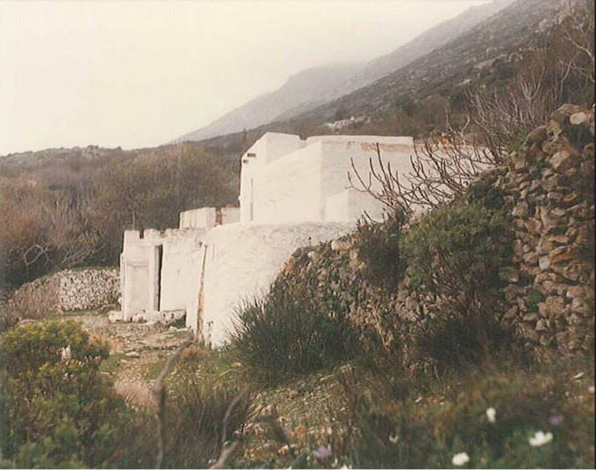
Staying on Amorgos through the winter 82-83 at the edge of the village of Langada. Genuine village life, quite primitive and romantic (no electricity, no running water) – nowadays the main road runs just outside the house.
The decision to stay on Amorgos over the winter came naturally. And then I could not but profoundly get influenced by the local music. And for sure there were plenty of opportunities for that throughout the year.
Reggae-era and the bass guitar:
20. Bob Marley and Aston Barrett
Reggae is Bob Marley, they say. But for me very important was also the bass-player of The Wailers, the man in charge of the arrangements of the famous tracks: Aston Family-Man Barrett. I was thinking he was not just playing the bass, but that he in the same time was stating philosophy.
***
21. Misty in Roots
Mid of 1980’s. Especially for our new started reggae-band – IRIE, a heavy influential album was the Misty in Roots – Live at “Counter Eurovision Festival”. It was like an apocalypse for us of what reggae was and how it could be performed. Again thankful to DJ Angelos for that recommendation.
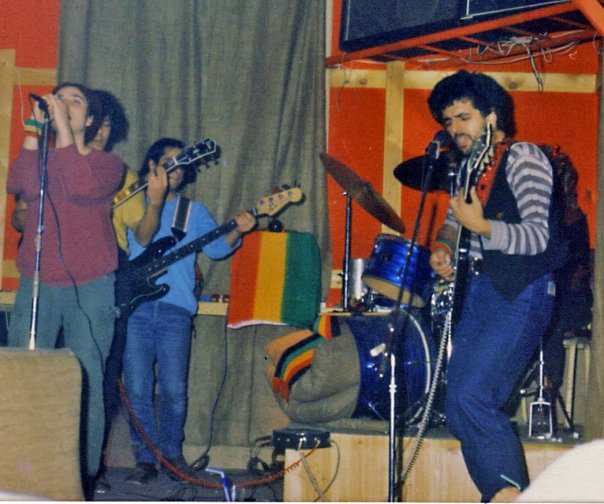
Playing the bass in IRIE mid of 80’s. We were a short-lived but intense and popular reggae-group, probably the first in Athens at that time.
22. Steel Pulse – Chant a Psalm
In times when there was no Internet to find lyrics and chords, Chant A Psalm became a real challenge to learn. Mainly thanks to the great music ear of my sister, we finally succeeded to play it … almost identically to the LP.
23. Winston Rodney – Burning Spear
Last but not least, Winston Rodney aka Burning Spear – the Teacher, still alive, still crying and calling on You:
https://youtu.be/S47fMwh_ZdU
Greek musical aspect:

Nikos Papazoglou live concerts at Lykavitos Theatre – became true folk festivals hard to forget.
For sure, Nikos Papazoglou and the legendary album Η Εκδίκηση της Γυφτιάς (I Ekdikisi tis Gyftias) 1979, was a great reintroduction to Greek music. Together with the text writer Manolis Rasoulis they produced songs that still goes straight to the heart. Unfortunately both of them died one shortly after the other in spring of 2011. Here a rare recording of them in younger age, performing Στη ρωγμή του χρόνου – Sti rogmi tou xronou, music by Nikos Xydakis.
24. Papazoglou and Rasoulis:
Rebetika *
* Little did I know when writing this post about what was in for me exactly the period that followed, summer 2015 to today. Almost by an accident I fell into the deep study of rebetiko-guitar which led me to completely other horizons than I ever could imagine when writing the current post. More about my lately rebetiko-trip will soon be found here.
Nevertheless, the songs presented below are still milestones in my love-story with this music
Rebetika music could of course not be excluded from this list. It is difficult to chose only a few from it’s vast ocean of songs. However, the track below has been following me over the decades without to decrease in importance. It is performed here by my favourite singer Prodromos Tsaousakis – Πρöoδρομος Τσαουσöaκης.
25. Γλυκοχαράζει ο Αυγερινός – Glykoharazei o aygerinos, Tsaousakis
26. Tsitsanis – To Gramma (the Letter)
Talking rebetika the figure of the great teacher Vasilis Tsitsanis cannot be avoided. Here in a less known but for me in recent years deeply beloved track, covered with the amazing voice of Stella Haskil.
The oud and Minor Asia influences
The Anatolia Peninsula (Minor Asia) has throughout history been homeland to, or occupied by, a vast number of historical people. It is my firm opinion that the music originated in Minor Asia under no circumstances can be classified using our modern narrow (nationalistic) terms. For thousand of years this area has been a boiling pot of several cultures and so is the many-flavoured music produced thereby.
Learning the oud automatically brought me in deeper contact with the music from the Minor Asia and the former Greek populations of the Ionian coast.
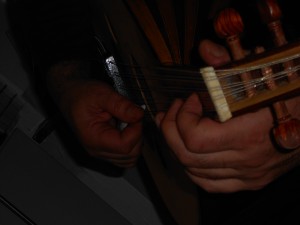
I held an oud first time in my hands at beginning of 1990’s and decided immediately that I just had to master that divine instrument.
My first practical oud-teacher told that learning the instrument would require several years of intense practise:
– The first three years would be spent in learning tuning it.
– The following three years would be those of a novice, learning the basic techniques and scales, the makams.
– Then would come another three years were the playing starts on more serious level.
– Three years further than that – after summary 12 years – one can say the instrument is mastered.
I managed to reach 7-8 years of playing. Then real life came in between and I didn’t touch the instrument for almost a decade. In the latest year I have made some smaller efforts to go back to the oud. Let’s see where this action will lead.
27. Τα παιδιά της γειτονιάς σου – Ta paidia tis geitonias sou
The above classical song, performed by Marika Papagika, is perhaps the one I have played the most until now. Actually it was this song that I had to performed to get my one and only acquired diploma in oud and Byzantine music – somewhere towards the end of last century. An interesting aspect of this song is it’s changing rhythms and makams between verses and bridge. Makams involved: saba and usak.
28. Pergamos – songs of the lost homeland.
Many of these songs are associated with the refugees after the Greek national catastrophe of 1922. Pergamos describes the pain of fleeing the ancient homelands. It was through this song I learned the beloved makam karcigar – took me several months though. Pergamos is performed here by my first oud-teacher and his wife, Nikos and Giasemi Saragouda. Click on picture of Great Fire below to listen to them on YouTube.
World/Ethnic music
We are now reaching beyond Anatolia further down the Mediterranean costs, across the Arabic deserts and up to the Spanish mainland.
29. Hamza el-Din – from Nubia
Our first stop is Nubia, somewhere between Egypt and Sudan. Here I discovered the Nubian teacher Hamza el-Din as early as the 1980’s, due my access to the vast archive of the Swedish State Radio –Grammofonarkivet, one of the world’s biggest and most precious collections of records. He has since then been following me closely, inspecting my progress o the oud.
30. Lama Bada
An important station in life was my travel to the Holy Land in 1987 and the long staying in Jerusalem over the summer. I started now to come in closer contact with both Arabic and Jewish music and culture. This religious song has Andalusian origins, probably from times before the Spanish Expulsion of 1492. I first heard it from Hamza el-Din and later I spent numerous hours learning to play it on the oud, note by note. It is performed here by the Israeli group Abraham Bustan – the garden of Abraham.
31. Huseyni Pesrev
When I came so far on the oud as playing directly from note sheets, I was encountering the magnificent classical music of the Orient, the classical Ottoman music, equivalent to our more known Western classical music. One of those compositions still touching very deep strings is the Huseini Pesrev, (makam Huseini) performed here by Evgenios Voulgaris on Yayli Tanbur.
Latest years 50+

Going back to Sweden in 2005 meant not only revisiting Stockholm but also getting to know the lowlands of southern province of Skåne and the city of Malmö better. Somewhere there a long musical pause fortunately came to en end.
Short after the beginning of the millennium, I was going through a long break up with music and musical instruments. But recently there seem to be a new dawn and a stark revival. Also, together with some good friends in Malmö, we started small musical late-night jamming sessions – we call them HullerOmBuller – that have helped resurrecting the spirit of music in me. During those sessions various new musical contacts has been made, especially with the traditional Swedish folk music and the most influential troubadour Carl Michael Bellman.
32. Carl Michael Bellman – Epistel nr 81
Our greatest jamming hit until now and, in general, perhaps the most popular song of Bellman is the above Epistel nr 81, or better known as Märk Hur Vår Skugga, here performed by modern times troubadour legend Cornelis Vreeswijk. Click on the above picture to listen.
Introspective (all times)
Finally, I have to include a composition that still keeps haunting my most introspective and meditative moments. It has been following me from my earliest student years, then as a badly scratched LP in vinyl, today in a digitized Spotify-version:
33. Stravinsky – Sacre du Printemps
Sacre du Printemps (Rite of Spring), short description: The original subtitle is Pictures of Pagan Russia. In the scenario, after various primitive rituals celebrating the advent of spring, a young girl is chosen as a sacrificial victim and dances herself to death. The below Leonard Bernstein version is a copy of my first LP.
And this was the end of My Music List. Thanks for following through all of it. There are for sure many titles I have forgotten to include, but in general the list gives a touch of all those years that passed.
Let’s see now what the future has to offer…

